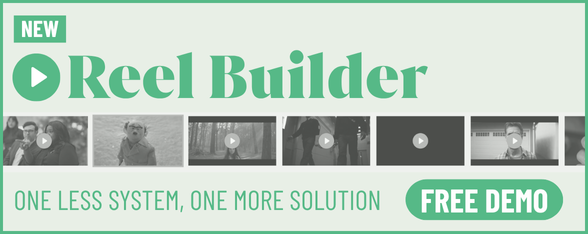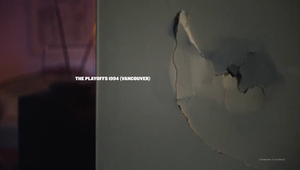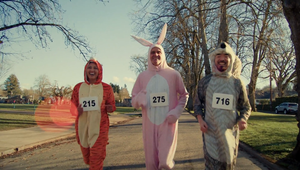
The Directors: Christopher Nataanii Cegielski

Christopher Nataanii Cegielski is an LA-based director, writer and member of the Navajo Nation whose work and character exudes youth and ambition.
Recently, Christopher was a fellow of the DGA and AICP’s joint Commercial Diversity Directors Program (CDDP), whose purpose is to increase diversity representation in commercial filmmaking. He has recently worked with clients such as ABC, United Airlines, Google, Youtube, Altra, AriZona Beverages and DIG DEEP on their Navajo Water Project.
Christopher’s narrative work has received international recognition from festivals such as the Berlinale, SXSW, imagineNATIVE, Sun Valley, and the LA Film Festival. He has received artistic development from the Sundance Native Lab’s Time Warner Producers Fellowship and Film Independent’s Project Involve Program, where he received the Sony Pictures Diversity Fellowship Grant.
This year, Christopher made his television debut by co-directing a new docu-drama for History Channel set to release later in 2023.
Name: Christopher Nataanii Cegielski
Location: Los Angeles
Repped by/in: UnDivided/Canada & Voyager/USA & GoEast/Eastern Europe, Asia, Middle East
LBB> What elements of a script sets one apart from the other and what sort of scripts get you excited to shoot them?
Chris> This is a great question. I’m still attracted to the same foundational elements that make for any good script. Do I love the character or characters? What kind of conflicts do these characters run into? Are these conflicts a causality of the character's decisions? These little narrative elements are still very important to me when reading a script and trying to visualise the spot in my head.
As I’ve got more into action comedy, I’ve started paying close attention to the overall pace of a script. Does the action move at a calm and steady pace, or can we turn up the energy a little bit? Are there opportunities for us to play with tempo by speeding up the action, then slowing down time to highlight a fun joke or pivotal moment? I’m also excited about building multiple storylines and characters simultaneously, allowing them to play off one another in the edit to create comedy or suspense. It’s fun for me to develop each character's world and through line, then find creative ways to blend them all together through snappy camera work and fluid transitions.
LBB> How do you approach creating a treatment for a spot?
Chris> Usually after reading a script or brief, I take a moment and really meditate on the concept. What aspects of the script do I love? What aspects of the script do I find challenging? What areas of the concept can we elevate? In what areas can I implement my artistic voice and perspective?
Most of the time these questions start bleeding together, creating ideas and images to the point where I can start visualising the spot in my head. Then I do a quick search to find key reference images, GIFs, camera moves, transitions, colour tones and other stylistic inspirations.
This is when I whip out my computer, let my fingers do the talking and start hammering out the copy. For me, the copy is where I fully start wrapping my head around the project. I begin to make decisions and draw hard lines, using the treatment writing process as a parameter placement. How is this spot going to look? How is this spot going to feel? How are we going to use our camera to tell a story?
If the meditation section is where I let my creativity thrive without constraints. The treatment writing section is where I commit to specifics, splitting hairs down to details in order to really hone in my vision. Once I have the vision, I’m off to the races!
LBB> If the script is for a brand that you're not familiar with/ don’t have a big affinity with or a market you're new to, how important is it for you to do research and understand that strategic and contextual side of the ad? If it’s important to you, how do you do it?
Chris> I always think it's important to know your brand, their messaging, their creative direction, and what sort of ad’s they’ve done in the past. Many of these brands have been around for a while and come a long way to get to where they are now. So whether I’m familiar with a brand or not, I always like to tap into their journey and put myself into the brand's mindset.
I’ll look through their websites, social media accounts, past campaigns and even print material if I can find it. For me, it allows me to identify the voice of the brand and gives me a strong foundation for our creative calls.
LBB> For you, what is the most important working relationship for a director to have with another person in making an ad? And why?
Chris> That’s hard to answer because I think there are so many important relationships while working on a project. There are your clients, your DP, your AD, and of course the CD. I have a lot of fun working with the creative team to iron out creative details and figure out ways we can elevate the concept within their scope.
However, the most important relationship I’ve found is the one I’ve had with my producers. When you have a top-notch producer who believes in your vision and the project, it’s like having a knight in shining armour who’s always ready to save the day. During prep, every day there are a hundred little battles that need to be fought and a hundred little decisions that need to be made. When you have someone in your corner who’s feeding the creative vision and helping you make the best project possible, you can really feel the support from the top down, making everyone feel in good hands.
LBB> What type of work are you most passionate about - is there a particular genre or subject matter or style you are most drawn to?
Chris> I’m passionate about a lot of different kinds of subject matter and styles. To be honest, it’s kind of my biggest weakness.
When first getting into commercial directing, it was hard to get work because my reel didn’t fall into a specific category. I had some tonal sports spots, some romantic realism narrative-type spots, and finally some action-comedy spots. Even though their styles were different, each spot contained the same strong and identifiable voice because they centred around one of my biggest passions, which is highlighting my indigenous culture and community. Whether the spot focused on a runner, took you on a wild sheep chase or informed you about a non-profit working on the Navajo reservation - my main passion was and still is, creating honest representations of our Native communities and empowering our people through film.
Lately, I found myself most passionate about narrative-driven projects that aim to tell their stories with a pulse of comedy. I used to think you needed to only direct dark and brooding drama spots to be considered a real artist. Then I did my first action-comedy spot and realised how fun it was. There was a lightness to the material, you were trying to make people laugh, and also I found it very artistically fulfilling. It allowed me to try out different techniques and tonal styles that I’ve always loved but never had the opportunity to use. From that point on, it changed my perception of an artist and allowed me to reanalyse what kind of director I want to be.
LBB> Have you ever worked with a cost consultant and if so how have your experiences been?
Chris> I always try to work as efficiently as possible, aiming to over-deliver and punch above my weight class with every job I direct, and I work really hard to communicate that at every stage. I think because of this when cost consultants get involved I’ve been able to successfully advocate for my vision and make sure that the shoot has what it needs in place to be the best it can be.
LBB> What’s the craziest problem you’ve come across in the course of a production – and how did you solve it?
Chris> I remember when we were filming my New Balance spot, which follows a Navajo Granda on an epic spaghetti-western foot chase to catch one of her runaway sheep, there was one shot I knew was going to be very difficult.
In this shot, the runaway sheep is standing in the middle of the field minding its own business, then we snap zoom onto the sheep, where the sheep turns and runs away, starting our chase sequence. In order to pull off this snap zoom, the sheep needed to be set in the middle of the field, then our sheep wranglers needed to clear the frame, which was about 40 feet away from the sheep. As you can imagine, sheep don’t sit still or pick up action cues like other animals. We had a very tight schedule and I knew we had only a couple of attempts before we needed to audible to my safety shots.
I made the entire crew find their places and settle. The wranglers had our sheep on their mark. I told our DP to start rolling. Slowly the sheep wranglers started easing off towards the frame, very calm and quiet. As soon as they cleared our frame, my DP snap zoomed onto the sheep, and like Gene Kelly hitting his mark, the sheep turned and ran off the frame. This was our first take. I remember my DP and I both looking at each other with fat grins on our faces as we both said, “Let’s move on!”.
LBB> How do you strike the balance between being open/collaborative with the agency and brand client while also protecting the idea?
Chris> Collaboration is one of my favourite aspects of the filmmaking process. I love working with passionate agencies and clients who are eager to make our vision come alive. More often than not, I find that the creative teams already have a pretty strong vision of what they want for a spot and what they want to achieve. It’s our job as commercial directors to listen to those ideas and infuse our own perspective to elevate that vision.
For me, the main reason the treatment and pitch process is so important is to get aligned on that collaborative vision. Through these decks, I truthfully and honestly lay down what I aim to accomplish. I never try to hide anything from the creative team, I never try to bait and switch, and I always try to be as thorough as possible.
This way if you’re awarded the bid, we’re all protecting the same idea. I’m all for creative collaborations and adjustments throughout any time of the production process. However, when we start deviating away from the project and the main ideas we all agreed upon, that’s when I have to start redirecting our team back to the project we all fell in love with in the first place.
LBB> What are your thoughts on opening up the production world to a more diverse pool of talent? Are you open to mentoring and apprenticeships on set?
Chris> I’ve been part of some great film and artistic development communities throughout my career, which has allowed me to build a strong and diverse film community from the beginning. I feel fortunate to say that diversity within my productions is an inherent quality that I’ve cultivated and continue to nurture with every project.
As a native filmmaker, I’m always looking to bring more indigenous creatives, production personnel, or curious minds into the fold. I’ve been lucky enough to learn from many mentors through shadowing opportunities and I’ve always been excited to return the favour. Through this practice, I find we can continue to learn and grow from one another, with one another, and make these projects feel more like a communal experience as we continue to build towards our dreams.
LBB> How do you feel the pandemic is going to influence the way you work into the longer term? Have you picked up new habits that you feel will stick around for a long time?
Chris> To be honest, the pandemic didn’t really change my approach or alter my working process to a great extent. Of course, there were little things added to insure people's safety but a lot of the digital aspects such as remote casting, remote location scouts, zoom meetings, etc - were already being utilised prior to the pandemic but were more solidified during that time.
I pride myself on being pretty adaptable and rolling with the punches when life throws some haymakers. With that said, one of my favourite aspects about working on a production is the people and the communal experience it provides. That's what gives me true joy, so I’m glad we’re able to do that again.
LBB> Your work is now presented in so many different formats - to what extent do you keep each in mind while you're working (and, equally, to what degree is it possible to do so)?
Chris> Back in 2015, I was mentoring a summer film workshop for high school kids on the Navajo reservation. This was around the time when the iPhone started really upping their game with the camera capabilities. People started filming more videos on their phones, posting them to YouTube, or utilising apps like Vine. And I remember there was this big division on how to properly hold your phone while filming a video, horizontally or vertically. I remember we showed every single workshop this long video essay we’d found that basically dogs on people who hold their phones vertically and why you should always hold your phone horizontally when filming. It's more cinematic, it’s the way we’ve always filmed, theatres are 16X9 and not 9X16, etc, etc.
Long story short, I had no idea that the vertical video was going to be so embraced by our culture to the point we’d have to frame for horizontal and vertical video at the same time. However, it’s just one of those things you need to learn and adapt to. I’ve had multiple projects where we’ve needed to frame for 16X9 and 9X16 at the same time and it’s an aspect of the commercial making process I’m continuing to fine-tune.
LBB> What’s your relationship with new technology and, if at all, how do you incorporate future-facing tech into your work (e.g. virtual production, interactive storytelling, AI/data-driven visuals etc)?
Chris> I would start off by saying that I’m a huge fan of visual effects. Even though I don’t use a lot of visual effects in my own work, it’s a filmmaking tool I’ve wanted to implement more in my repertoire and I’m always looking out for opportunities to do so. I’ve always admired the artistry behind it, how it can add an extra layer of creativity and open up the scope of your cinematic universe.
As far as new technology goes, I have pretty limited experience. I’ve never done a virtual production, I’ve never done interactive storytelling or any AI/data-driven visuals. I’m open to learning more and integrating some of these forward-facing technologies into my work. However, I love being practical with my filmmaking. Whether that means creating practical builds or going out on location, there’s nothing more I love than being with my crew and getting our hands dirty.
LBB> Which pieces of work do you feel really show off what you do best – and why?
1. New Balance - For Any Run
Chris > This was the first action-comedy spot that I did and really shifted the way I see myself as a director. It allowed me to focus on a singular story and subvert the viewer's expectations in a real and humorous way. It also allowed me to play with pace, push through actions with kinetic energy and then slow down time to highlight fun moments. Last but not least, it allowed me the opportunity to use techniques that I’ve loved ever since I was a kid such as snap zooms, whip pans, spaghetti western tropes and classic kung-fu action conventions.
2. Lakers - In This Together
3. Come Run, Come All - Altra
These two spots came after my New Balance spot and showed how I became inspired to switch up my style a bit. I particularly love how each of these projects follow simultaneously storylines and characters, building off one another through the edit to create a sense of unity or humour.
4. This is Home - ABC
Out of all my projects, this might be the one I’m most proud of. It just meant a lot to me, from it being a Native American Heritage month spot, to the diversity we were trying to highlight in our own communities, to all the talented and inspiring people we were able to feature. This was one of those projects that made me feel, I’m doing what I was put on this world to do. It was beautiful, it was powerful and most of all it was a communal experience.















